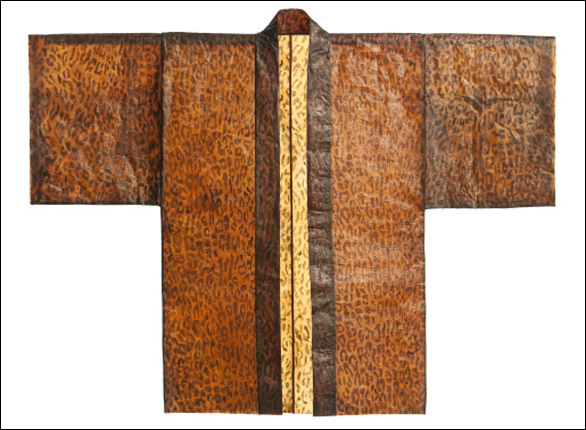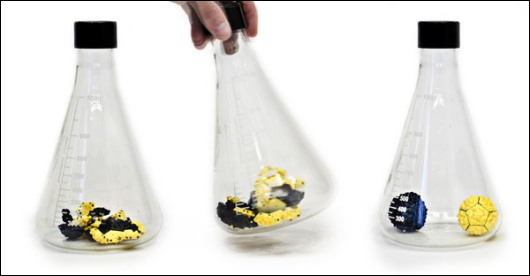 Fashion designer and BioCouture founder Suzanne Lee harnesses the labor of microorganisms to grow clothing. Computational architect Skylar Tibbits — who’s setting up a lab at MIT focused on self-assembly technologies and programmable materials — examines biological systems to develop his methods. We asked them to discuss the directions they’re exploring, and the trends and challenges inherent in working with natural processes to meet humanity’s needs.
Fashion designer and BioCouture founder Suzanne Lee harnesses the labor of microorganisms to grow clothing. Computational architect Skylar Tibbits — who’s setting up a lab at MIT focused on self-assembly technologies and programmable materials — examines biological systems to develop his methods. We asked them to discuss the directions they’re exploring, and the trends and challenges inherent in working with natural processes to meet humanity’s needs.
Your work seems to reflect a real trend in using technologies inspired by nature — not only in the design, which has happened on and off for centuries, but in the way you produce and fabricate the things you make.
Skylar Tibbits: From my perspective, it is not about inspiration from Nature, and in many cases, we probably shouldn’t take inspiration from nature. Rather, nature is a good example of the systems we are exploring — but there are many non-natural systems that demonstrate similar principles.
My work really started from the architecture side, then got pulled towards computer science when I was at MIT. I took lessons from self-replicating systems, self-regulating, digital information/majority voting, redundancy and some of the fundamental ideas introduced by Turing/Von Neumann, and so on. The link to nature — proteins, cellular replication/DNA — really only came after the fact, when I realized that the systems I was producing were incredibly close to those found in nature.
There is obviously a huge trend at the moment for bio-inspired design and biomimicry, but I believe many of these proposals have fundamentals flaws. Natural systems evolved for very specific reasons, over millions of years, with very specific parameters, scale-lengths, forces, and so on, and the process of translating these phenomena to other scales, function and human desires does not come naturally or directly. We should not simply assume that systems working at nanoscales can easily be translated to large scales. And if we do, why not change the parameters — why would the translation have to be entirely direct?
The second flaw is the tendency to use nature as a source for aesthetic inspiration — the assumption that if it looks like nature then it is or works like nature. Finally, I see our tendency to look past the facts of evolution and why systems have specifically evolved in a particular direction. Many — maybe all — natural systems took some path of evolution where each mutation was built upon the last, and decisions along this journey were arbitrary and extremely specific to its time, place, climate and scale. So natural systems work very well for some things, and in other cases don’t work at all for what we are looking for.
That said, I think there are a number of very interesting developments in science, engineering and design that are not only taking inspiration from nature — they are literally using nature — such as DNA origami (or self-assembly of DNA strands to build 2D and 3D shapes at the nano-scale). Biological processes are far more complex, efficient, precise, adaptive then nearly any manmade process or machine we have today, so it makes perfect sense to use biological processes for what they are good at, or manipulate specific variables within them to achieve something they could never have arrived at themselves. This points to Suzanne’s incredible work with cellulose. The cellulose doesn’t naturally want to build clothing per say, but we can harness its natural abilities with our own knowledge of the process to achieve something higher.

Top: Skylar Tibbits shares how self-assembly works. Above: A kimono made of Lee’s microbial cellulose. Photo: BioCouture
Suzanne Lee: Skylar’s quite right — bacteria aren’t desperate to generate dresses! The emergent field of synthetic biology enables us to have the best of both worlds. We can harness the best bits of biological systems to design and build entirely new organisms that better fit our needs. This is not without complex ethical issues, however, and hopefully an internationally agreed and robust ethical code will develop simultaneously with the potential engineering advances.
My work isn’t really inspired by nature. It IS nature. I’m interested in exploiting living organisms to create biodegradable products. In my opinion, the design trend towards biomimicry is about putting the designer ego to one side and accepting that nature has already come up with so many inspirational design solutions. This doesn’t necessarily lead to design looking or feeling “naturalistic” though.
I do agree about the flaws inherent in directly translating from nature and how there can be issues relating to scale — I see this as both limitation AND opportunity. Understanding scale in a biological sense is still a challenge to me as a non-scientist! I find scientists are very happy jumping from discussion of proteins, to bacteria, to fibres to materials – daunting conceptual jumps from the nano to the macro scale.
How do your approaches differ?
Skylar: Our work comes from from different starting points and it’s applied at different scales. I am not working directly with natural processes, although I have started a few collaborations with molecular designers recently, working on DNA origami, that may prove to be fruitful in the coming months. I mainly look toward the natural processes as a resource manual, comparatively looking at how those processes work and how my designed/engineered processes function. How does DNA store discrete information, how is it so good at self-regulating and error correction, how do proteins store their assembly information? None of this is meant to be translated 1:1. Rather, it becomes another model or example where it happens and we can learn from it.
I have a lot of experience working with physical/building-scale materials (plastics, wood, metal, casting, “bricks” etc) — and these inherently become the material palette I work with. However, I try to focus on these “dead” materials and embed information directly into them to offer more “active” characteristics (usually without motors or electronics). I’m trying to discover how much information can they store, how can they replicate inherently, how can they move and assemble themselves, and so on. None of these properties are necessarily found within the materials themselves. Rather, it’s a different way of looking at the materials and at the way we build things.
Suzanne’s work came from a completely different direction and uses far different “materials” and applications, thus leading to the different aesthetic output.
Suzanne: I’ve personally come full circle from loving techno/sci-fi aesthetics and being excited by material innovations that build “smart” complexity into systems and surfaces to embracing nature’s “smart.” I’m now driven by the entire product life-cycle using renewable resources or ideally local waste streams to create biodegradable materials. By harnessing a living organism to manufacture for you the resulting material or product needn’t look “biological” or “organic.” But it does offer opportunities to build in biological functionality.
What issues around working with natural systems do you discuss between yourselves? What do you have in common, and what else are you thinking about and investigating together?
Suzanne: We both struggle with new notions of manufacturing processes and time. We share an interest in being “hands off” — allowing structures to self-generate, Sky by designing this into architecture so that they are “compelled” to organize, and my own work with living organisms that simply require the presence of nutrient to create material forms.
With each approach, the time it takes for construction may be longer OR shorter than a “traditional” method, challenging existing limits and opportunities. I’m always asked how long it takes to grow a garment (answer: approximately three weeks) — as though this were the only barrier to mass adoption. But it makes little sense to contrast this with the supply chain lead times for a comparable “conventional” garment because that never factors in the time it takes to obtain the fibre in the first place — cotton plant to t-shirt? petroleum to nylon jacket? grazing animal to leather handbag? For example, in a fermented process, product can be simultaneously formed as fibre is spun and dyed — multiple production stages condensed into one. A more useful comparison would include factors such as resource consumption, carbon footprint, end of use, and so on.
Skylar: I think an interesting point to discuss would be the scale of the application and how far we can push biological/natural processes outside of their comfort zone. Suzanne and I have talked a lot about how far could you push a biological process to the scale of a building. For example, could you produce cellulose or other materials to grow to extremely large-scales? How long would it take, how do you build a scaffolding etc). And how can you “seed” it’s growth, working hand-in-hand, giving it constraints, waiting for the reaction, giving further constraints?
Suzanne: Firstly you can engineer an organism to produce the attributes you desire (when to biodegrade), then arrange these into a particular structure (fibre alignment) and finally engineer the overarching parameters to respond to external stimuli (water resistance).
Aesthetically and practically, I’m not sure either of us has arrived at something that we suggest is perfected or finished. To date I’ve embraced the natural aesthetics that emerge from the process as it helps to explain a narrative (this is in stark contrast to how we normally approach fashion: fashion relishes artifice). Ultimately it’s not what I’m striving for, but for now it serves an illustrative purpose.
Regarding scale, I would argue that we both come from backgrounds which use the human body as starting point for considering scale: Vitruvian, Corbusier’s Modulor, Fibonacci, golden section, and so on. That’s why I struggle with suddenly zooming into the nanoscale! For me the challenge is to understand how by mastering what is happening at the nanoscale we might design the ideal macro qualities.
What interests me about what Skylar is doing is how he might bring biological attributes to large-scale structures, this may be with steel, wood or plastics. But I’m also intrigued to know if (biologically) living systems could play a role. We have no idea what new hybrid materials/fabrication techniques will emerge in future — rampant mutant algae that turn to concrete? It’s exciting to think the solutions could be located somewhere within the space between our respective work. I think we are entering a dynamic new era for design where, with scientific collaboration, we can explore all manner of material and manufacturing innovations.

Growing microbial cellulose. Photo: BioCouture

Chiral Self-Assembly: Autodesk Univ., Las Vegas 2012. Photo: SJET
Skylar: I totally agree — biological attributes at large-scales is extremely interesting. There is certainly a lot of work going into gradient density materials and adaptable performance in materials or building systems. An opportunity might be to utilize natural processes for their ability to respond to passive sources of energy, their natural tendency to “adapt,” and for their internal ability to have “desire.” Man-made systems lack the ability to have “desire,” this gets into the theories of artificial intelligence — and how can a system make decisions internally without external programs or command. How can a system write its own code, or where does the initial genetic code come from?
Natural systems obviously have this built in — the ability to have a desire. Plants, for example, generally have the desire to grow towards light and they generate energy from the translation of photosynthesis, carbon dioxide to oxygen, and so on. This is extremely difficult to build into synthetic systems — the ability to “want” or need something and know how to change itself in order to acquire it, or the ability to generate its own energy source. If we combine the processes that natural systems offer intrinsically (genetic instructions, energy production, error correction) with those artificial or synthetic (programmability for design and scaffold, structure, mechanisms) we can potentially have extremely large-scale quasi-biological and quasi-synthetic architectural organisms.
DNA origami is one of the only examples where we are forced to use a process of self-assembly simply because there is no other way to build at that scale. If we want to build structures at extremely small scale-lengths, then we need to work within their arena, on their terms. DNA is an amazing building material because it has rather “simple” units and interconnections, it has a language or interface for design, i.e., programmability, and it has a process where it can transform based on energy.
I think that we will soon see applications that are extremely similar to DNA origami but at very large scales. Instances where we currently cannot build what we want simply because we don’t have the right materials or machines/processes — these are perfect applications for new types of methods in assembly and new processes for design. This is where collaborations between designers and natural systems can have powerful applications/implications.
Why the drive to look to to nature to innovate manufacturing processes in the first place? Why now?
Skylar: There are two possibilities: Are we at a place where we’ve pushed the limits of material properties to extreme possibilities and dexterity, developed wonderfully innovative solutions for fabricating these new materials and even beginning to find automated processes for assembly — yet the ever changing demands of society, economies, climates, technology and scale (large or small) are requiring adaptability at such dramatic scales and paces that our current modes of production don’t cut it, forcing us to find infused processes of Frankenstein bio-adaptive and manmade processes? Or are we just looking for new modes of inspiration, toolsets and mediums, and the natural tendency is to look at our biological counterparts for dialogue?
Suzanne: I think there’s both push and pull taking place. If we look to the history of design, radical innovation mostly occurs where ground-breaking materials or manufacturing techniques are introduced. Human creativity is constantly pursuing the new. At the same time, we do indeed face so many environmental, economic and societal challenges that current resource inefficiency and wastage has become obscene, driving the need for change. In both our work we also seem to be proposing very limited human intervention. We haven’t really discussed what this means for the workforce. Our workers seem to be robots, autonomous structures and biological organisms, but that’s a whole other discussion!
Comments (14)
Pingback: Skylar Tibbits of MIT Self-Assembly Lab, Opening Keynote for #ZWC19 – Metro Vancouver Zero Waste Conference Blog
Pingback: Harnessing Nature’s “Desire” to Manufacture Our Eco Fashion of the Future | saving time, money when you compare
Pingback: 4D Printing: Manufacturing Intelligent Machines
Pingback: Are you ready for this …. 4D Printing is on the way. - 3D Printing Industry
Pingback: Skylar Tibbits presenta la impresión 4D en TED2013 | It's a 3D World
Pingback: Skylar Tibbits apresenta a impressão 4D na TED2013 | It's a 3D World
Pingback: Skylar Tibbits presents 4D printing at TED2013 | It's a 3D World
Pingback: 4D Printing Could be the Future of Manufacturing | Rapid Ready Technology
Pingback: Skylar Tibbits apresenta a impressão 4D na TED2013 | It's a 3D World
Pingback: 4D Printing Is The Future Of 3D Printing And It’s Already Here | WebProNews
Pingback: Skylar Tibbits presenta la impresión 4D en TED2013 | It's a 3D World
Pingback: Skylar Tibbits presents 4D printing at TED2013 | It's a 3D World
Pingback: Wizmo Blog » Blog Archive » Hypernatural intelligence: A Fellows Friday conversation with Skylar Tibbits and Suzanne Lee